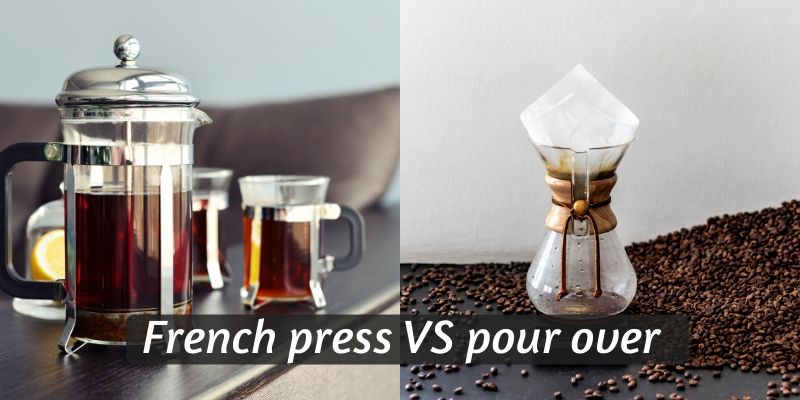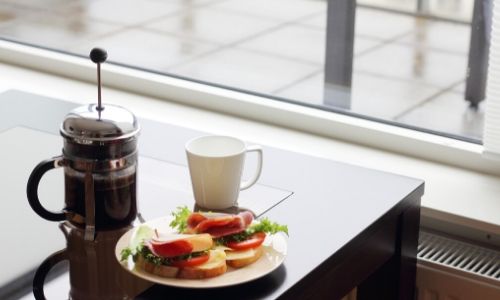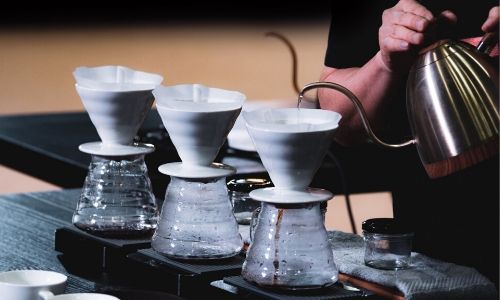Wondering is you should brew French press, or pour over coffee instead ?
After all, both methods have their benefits and are simple enough to use. Read on to find the main differences between them, and also the benefits of each method.
Table of Contents
1. French press is a little easier to use
If you're looking for ease of use, then you might be better off with French press.
This is because everything's happening in just one, big glass pitcher. All your water and coffee are in one place, so is the plunger, mesh filter and at the end you just pour the coffee out of the one container.
Simple, not much to keep track of.
Pour over coffee has a different approach to things, though. It's going to require you to time a few elements, such as heating the water, how you pour it, making sure the filter is well placed, and giving the coffee enough time to brew.
This involves the glass pitcher, the filter, the kettle, and a timer.
As an upside to pour over coffee needing so much attention to detain, possibly more than French press, you can make your coffee as you choose.
As in, you can go slow or fast with the pouring, resulting in a coffee that's going to be stronger or lighter, and it all gets very specific when you make it your way.
Of course, the French press can be customized as well. But you can't really let it brew for more or less than 4 minutes, for reasons I'll cover in just a bit.
So it looks like pour over is the most customizable of the two.
2. Grind sizes are different, thus the coffee is different
The main reason you can't let French press coffee brew for too little or too long - it uses coarse grounds.
This means it needs a longer steep time, and you can't really get away with steeping it for just two minutes.
Coarse coffee needs time to fully release its flavor, and you should really let French press coffee steep for about 4 full minutes. This is after the coffee has bloomed.
This is the same reason cold brew uses coarse ground coffee, since it releases its flavors differently.
You see, the larger the grind size, the less bitterness and acidity there will be in your cup of coffee. It has to do with which compounds get extracted first, and it seems coarse ground coffee ends up better.
To get around this, for example for a cup of fine ground coffee you need to opt for a short but intense brew time (think espresso).
Pour over coffee can use pretty much any grind size, aside from coarse ground.
Traditionally it uses medium or medium-fine grounds, much like drip coffee or a Moka pot.
You can use fine ground coffee in a pour over setup if you like, or that's all you have on hand. You just need to be quick when pouring the water, otherwise it'll come out too bitter.
Generally, French press ends up tasting smoother, with more body than pour over.
On the other hand, pour over tastes 'cleaner' a little lighter.
3. French press is a little grittier, less filtered
French press uses no paper filter at all. All it uses is the metal filter, which is enmeshed in another fine wire mesh/filter.
This is to keep the coffee grounds out of your cup of coffee, and to make sure they really stay down when the plunger is pushed.
This results in all the essential coffee oils to be lifted from the ground coffee, and deposited into your cup of coffee.
It also allows very fine coffee dust to really make the coffee stand out, much like you would taste in an espresso or Turkish coffee.
This might be great for some, or not so much for others.
By comparison, pour over's paper filter manages to catch most of the coffee oils and nearly all the coffee dust. You get a clean cup of coffee that you can see through, if you choose to.
In some cases this might be the better option, like if you're very sensitive to strong-bodied coffee and would like a lighter coffee.
One thing you should note, the presence or lack of coffee oils and the small amount of coffee dust will change the overall taste of your coffee.
French press tends to taste stronger, have more 'oomph' than pour over, even if you brew a strong pour over. It ahs to do with the texture, and it also holds up better to any milk and sugar you'd like to add.
Benefits of using the French press method
There are benefits to both the French press and the pour over method. Which you use is up to you and what you're after.
So, the benefits of making your coffee with a French press are:
First, a better tasting coffee. Sure, taste is subjective but French press routinely gets reported as one of the most flavorful cups of coffee, along with cold brew and espresso shots.
Second, if you've got a grinder that doesn't work very well and can only manage coarse grind, then you're in luck. Trying to make French press coffee with anything but coarse ground coffee would result in a weird cup.
Third, you can do something else in the 4 minutes it takes to brew the coffee. It might not sound like much but in the morning rush you'll definitely be thankful for those 4 extra minutes.
If you're going to make French press coffee at home
You'll need a good French press if you're going to make your coffee at home. A sturdy, comfortable one that's going to last you for years and years.
I recommend you try the one by KONA, they've got a 34 oz/ 1 liter version that's definitely going to get you the coffee you're after.
You can find the listing for it on Amazon right here.
It says it can brew 8 cups, but keep in mind those are small cups - 4 oz/120 ml ones to be exact.
The press is easy enough to use, and can be taken apart and put back together in minutes, for when you want to give it a thorough cleaning.
Benefits of using the pour over method
The benefits for pour over are a little different. It's a more involved coffee, and it might just be up your alley. Here's the main benefits:
First, you control absolutely everything. If you're a bit of a control freak, then you'll want to be specific about the water temperature, how quick or slow you pour the water, how long you let the coffee bloom, and how long your overall brewing process takes.
This is not the kind of coffee that you just walk away from. No, you stand (or sit) there and watch over every detail. Some find this process very soothing and relaxing, and it might be for you too.
Second, you get a cleaner, clearer cup of coffee. Pour over coffee is filtered coffee, and most of the coffee oils and dust will be caught by the filter, along with the grinds themselves.
Meaning you won't find tiny particles of ground coffee in your cup, and for some folks this is the best method to really taste the origin of the bean.
If you're going to make pour over coffee at home
A pour over setup is going to be more complex than a French press, but also going to give you more precise coffee.
First, you need to start with the vessel itself. Now, there's many companies that are going to do a fine job of this, but the original and the best is the Chemex.
I recommend you get the 10 cup version, simply because it measures in 10 5 oz cups, resulting in a total of 50 brewed ounces. That's 1470 ml in metric.
You can find the Chemex listed on Amazon right here.
Then, you'll need the paper filers that are meant to catch the coffee grounds. You'll notice they're a little thicker than regular paper filters. This is good, because they need to withstand quite a bit of pressure and weight.
You can find a 100 piece set on Amazon right here.
And finally, you need the kettle to heat your water with. Almost always, folks end up using a gooseneck kettle because it offers way more precision than anything in the world when it comes to pouring.
So I found one by OXO, and it's a pretty neat one. It comes with a thermometer built into the top. It'll give you accurate readings, meaning you'll have less of a chance of ruining your pour over by using water too hot or too cool.
You can find the kettle with the thermometer on Amazon, right here.
It's a large enough kettle - can hold up to 1 liter/34 oz of water, so you can brew quite a few cups of pour over coffee with one full kettle.
Similarities between the two methods
After all's been said and done, there are a few similarities between French press and pour over coffee.
They might work a little differently, and they might have different brewing time, grind sizes and resulting flavors, but they've got some common points as well.
Caffeine levels are pretty much the same
While French press might seem like the obvious winner here - longer steep time - it may not be true. You see, French press ends up with a long steep time because of the grind size.
But pour over uses smaller grinds, in a shorter amount of time. If we take just that into account, the caffeine levels are going to be pretty similar.
However, to ruin everyone's day, it's not the brew method that determines the caffeine, it's the actual coffee beans themselves.
Meaning you can use a light coffee in a French press and a strong one in a pour over and the pour over would win.
What you need to be mindful of is what your coffee is made of: is it 100% Arabica, Robusta, or a mix between the two ?
Robusta is the strongest, but also the harshest coffee. Usually you'll find your coffee as a mix between the two. The more Robusta there is, the more caffeine there will be.
They both go well with medium and light roasts
Another thing to be said for both of these brewing methods, they are both good with medium and light roasts. There is the element of control that you have over the water temperature that ensures you don't scald the coffee.
Also, the longer steep times allow light roast coffee to really give everything it's got. As opposed to a quick process like espresso or Moka, for example.
Conclusion
Whichever method you use - French press or pour over - you're going to get a very delicious cup of coffee.
They each have their pros and cons, and it's up to you and your personal preferences to pick your favorite.
If you want to know more about coffee or tea, feel free to check the related articles below. Who knows what else you might find ?









